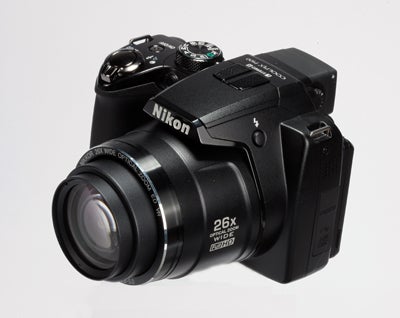Does the Nikon P100's feature list outweigh image quality issues?
Nikon Coolpix P100 Review
Nikon’s latest ultra-superzoom bridge camera certainly doesn’t do things by halves: the P100’s 26x zoom lens ranges from a wideangle 26mm right through to super-telephoto 678mm, there’s a new backlit 10.3MP sensor and even the capability to shoot Full HD 1080p as well as lower-resolution slow-mo movies at 240 frames per second.
Nikon p100-Features
There are some nice touches which make using the P100 that much more enjoyable, such as the vari-angle capability of the 3in, 460k-dot LCD screen. This makes shooting above of below eye level that much easier thanks to a user-defineable tilted screen, and is fairly key as the screen’s angle of view is rather limited when not directly face-on which can frustrate.
When not using the LCD screen an electronic viewfinder (EVF) also features that can be activated with the single press of a button to its side. The viewfinder’s quality isn’t anything to write home about but it’s of significant use when shooting at the longer focal lengths available. Indeed, with a maximum zoom capable of 678mm (equivalent), it’ll be tricky for anyone, however experienced, to hold a shot steady at this focal length.
Having your face to press the camera against when using the viewfinder certainly provides some rigidity to help keep shots sharp, with some further support from Nikon’s image stabilisation system. However, with a maximum f/5.0 aperture at this longest focal length, sharp shots will require a lot of good light – anything less and shots are extremely prone to blur, which was a commonplace issue when using the P100. Furthermore the EVF doesn’t automatically activate upon nearing the eye, and although this is not a major issue, fiddling around pressing the button to switch over to the LCD (which is frequently required for image playback preview) can become tedious (an auto LCD-based preview when using the EVF would eradicate this).
Nikon p100-Design
The P100’s design doesn’t break new boundaries and yet it’s perfectly as
expected in the hand. Buttons fit in the right places and the rear
thumbwheel makes for excellent use when cycling between settings
(quickly between apertures, for example).
As well as the usual Menu,
Playback and Trash buttons and standard D-pad on the rear, a
quick-access one-touch movie button can also be found which has a toggle
to select between HD (High Definition 1080p) and HS (High Speed
240fps). Shooting modes, including the full manual PASM controls,
feature in abundance on the mode dial to the camera’s top, which also
includes a user-defined (U) setting, Subject Tracking AF, Sports, Face
Detection and Auto Scene.
Other issues include a slow start up time, which can take anything from two seconds or even more before the camera is ready for use. Occasionally the camera also believed that a lens cap was attached when this wasn’t the case, to then later revert back to normal use – perhaps a nod towards the light-in-hand and plastic-feeling build quality. When this issue occurred there was notable light fall off at the wide-end, despite the lens appearing to have no obstructions.
Nikon p100-Value
Price-wise the P100 will set you back around £300 which, considering the feature set and relatively expensive competition, isn’t half bad. Other superzooms will undercut this price, but at the expense of focal length – there aren’t many other models out there that can match up to the 26x zoom.
Nikon p100-Image Quality
Image quality ranges from a sensitivity of ISO 160-3200, though images at all settings suffer from picture quality issues – perhaps surprisingly so given the new backlit sensor’s specification. Throughout the ISO range a granular-like image noise is apparent, with JPEG processing showing process artefacts throughout the image.
Clarity and sharpness is limited and diminishes as the ISO sensitivity increases – ISO 1600-3200 are fairly soft and muted due to noise reduction, though not unusable.
Metering tends to lean towards the overexposed threshold, though an exposure bracketing option does feature which may assist in countering this.
Colours, too, seem to be overly ‘pushed’, with purpley-pink shades appearing fluorescent and unrealistic, even when set to the ‘normal’ creative shooting mode.
As this is a superzoom camera it’s the longer focal length capabilities that will be of particular interest to the majority of prospective purchasers, and even here results are disappointing due to considerable chromatic aberration that sees subjects carry a purple-edged fringe that is considerable noticeable.
Verdict
For anyone seeking to buy a superzoom, the P100 is likely to make it onto your shortlist. With a strong features list it's an appealing option, but the overall weak picture quality and variety of performance issues are certainly a let down. Many competitors' superzoom cameras struggle to provide anything superior however, and the Nikon's significant zoom lens here is a clear selling point. The Full HD movie is a nice touch too, though the 240fps slow-mo is soft, low-resolution and has limited practical use. Ticks the features boxes, though overall use and results are just short of the mark in reality.





